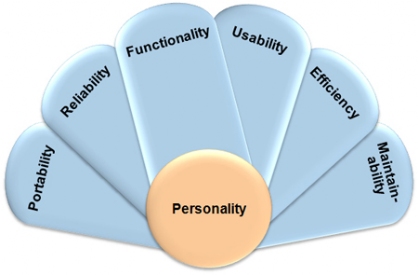Service Quality
The model of service quality provides evaluation criteria that can be used to evaluate services – whether these services are provided by people or fully automated. The model extends the quality model of ISO 9126 with criteria of personality. This can be used to create tools for planning, developing, implementing and monitoring. In the early phases of meaning design (e.g. idea development) general criteria are more likely to be used. Detailed evaluation criteria are needed in business engineering at the latest.
Service quality consists out of the six quality criteria of ISO 9126: functionality, usability, reliability, efficiency, portability and maintainability. These criteria are extended by the personality of the service provider – these are mainly people, but in the meantime automated services with virtual personal contact are existing, e.g. over the Internet and telephone.

Functionality
Functions describe tasks and purpose of a service. Detailed quality aspects are: provides the service the desired possibilities; does it delivers accurate results; fits the service into different environments; does the service provides enough data and information security; the service follows local rules and regulations.
Usability
Usability describes tasks and purpose of a service. Detailed quality aspects are: is the service understandable; easy to learn; easy to use and to control; is the service attractive for the customer; the service follows local rules and regulations.
Reliability
Functions describe tasks and purpose of a service. Detailed quality aspects are: provides the service alternative solutions in case of faults; delivers the service enough results in case of faults; is the service usable despite failure; the service follows local rules and regulations.
Efficiency
Efficiency describes tasks and purpose of a service. Detailed quality aspects are: does the service use an appropriate time frame; Resources are effective and efficient; the service follows local rules and regulations.
Portability
Portability describes tasks and purpose of a service. Detailed quality aspects are: can the service be adapted to a context; is it applicable in various contexts (e.g. language); does it fit to other services; can the service replace others; the service follows local rules and regulations.
Maintainability
Maintainability describes tasks and purpose of a service. Detailed quality aspects are: deficiencies and faults can be identified; changes of the service are possible; is the service stable after change; can it be tested; the service follows local rules and regulations.
Personality
Functions describe tasks and purpose of a service. Detailed quality aspects are: emanates the service provider enthusiasm; does the service provider have the appropriate skills; does the service respond to customer needs; the service is delivered credibly; is the service provider polite; the service follows local rules and regulations.
